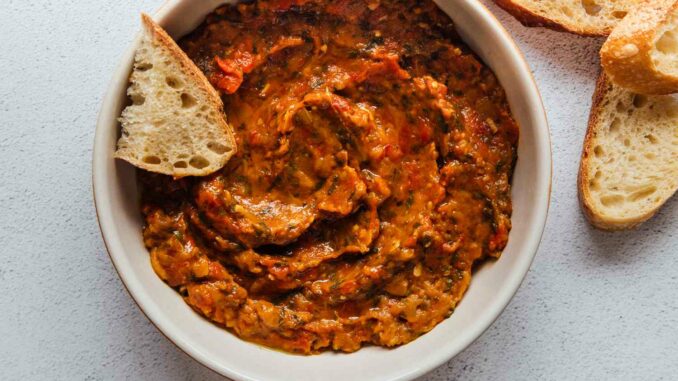
Introduction:
In the realm of Moroccan cuisine, Zaalouk emerges as a star, a dish that transcends its humble ingredients to become a flavorful representation of the country’s rich culinary tapestry. This comprehensive exploration takes you on a journey through the history, cultural significance, and the meticulous process of crafting the perfect Moroccan Zaalouk – a cooked eggplant and tomato salad that stands as a testament to the nation’s culinary prowess.
Part 1: The Roots and Cultural Significance
A. Origin in Moroccan Tradition
Zaalouk finds its roots deeply embedded in Moroccan culinary tradition, a dish that encapsulates the essence of local produce and the ingenious use of regional spices. Originating in the Amazigh (Berber) communities, Zaalouk has evolved into a beloved staple in Moroccan households.
B. Symbol of Seasonality
Zaalouk is a celebration of seasonality, with its ingredients reflecting the bountiful produce available in Morocco. The dish often features ripe tomatoes and eggplants, showcasing the importance of utilizing fresh, local ingredients.
Part 2: Culinary Evolution and Historical Influences
A. Berber Heritage and Culinary Adaptation
The Berbers, with their deep connection to the land, have played a significant role in shaping Moroccan cuisine, including the evolution of Zaalouk. The dish evolved as a response to the availability of eggplants and tomatoes, both of which flourish in the Moroccan climate.
B. Moroccan Spices and Flavor Palette
Morocco’s historical ties to trade routes and cultural exchanges have infused its cuisine with a rich tapestry of spices. Zaalouk showcases this spice palette, incorporating cumin, coriander, and paprika to create a harmonious blend that elevates the dish to culinary excellence.
Part 3: Essential Ingredients and Flavor Harmony
A. Core Ingredients
- Eggplants:
- Roasted or grilled to impart a smoky flavor and creamy texture.
- Tomatoes:
- Fresh, ripe tomatoes bring a burst of sweetness and acidity.
- Garlic:
- Crushed and minced for its aromatic pungency.
- Olive Oil:
- High-quality olive oil binds the ingredients together, enhancing the overall richness.
- Moroccan Spices:
- Cumin, coriander, paprika, and sometimes chili powder contribute to the distinct flavor profile.
B. The Dance of Flavors
Zaalouk is a dance of flavors where the smokiness of roasted eggplants meets the sweetness of ripe tomatoes, creating a symphony of taste. The garlic adds a subtle kick, while the Moroccan spices infuse the dish with warmth and complexity. Olive oil ties these elements together, ensuring a luscious and well-balanced salad.
Part 4: Crafting the Perfect Zaalouk
A. Traditional Preparation
- Roasting the Eggplants:
- Roast or grill the eggplants until the skin is charred, and the flesh becomes tender.
- Tomato Confit:
- Blanch, peel, and seed the tomatoes before chopping them finely.
- Garlic Infusion:
- Crush and mince garlic, infusing its bold flavor into the salad.
- Spice Symphony:
- Combine cumin, coriander, paprika, and, if desired, chili powder in a harmonious blend.
- Cooking the Zaalouk:
- Cook the tomatoes and garlic in olive oil until they form a rich, saucy consistency.
- Add the roasted eggplant, mashing it into the mixture while incorporating the spices.
- Simmering to Perfection:
- Allow the Zaalouk to simmer until it reaches a thick and flavorful consistency.
B. Variations and Personal Touch
- Texture Preferences:
- Some variations maintain a chunkier texture, emphasizing the individual components of eggplant and tomato.
- Herbaceous Infusion:
- Fresh herbs like cilantro or parsley can be added for a burst of herbal freshness.
- Preserving Zaalouk:
- Zaalouk can be preserved in jars with a layer of olive oil on top, extending its shelf life.
Part 5: Serving Traditions and Cultural Nuances
A. Zaalouk in Moroccan Meals
Zaalouk is a versatile dish, often served as a side dish or appetizer in Moroccan meals. Its ability to complement various main courses makes it a staple in family gatherings and festive occasions.
B. Bread as a Companion
Moroccan Zaalouk is commonly enjoyed with Moroccan bread, such as khobz, providing the perfect vessel for scooping up the flavorful salad.
Part 6: Conclusion
In conclusion, Zaalouk stands as a testament to the ingenuity of Moroccan cuisine, where simplicity meets sophistication, and local ingredients shine. Its journey from the heart of Berber tradition to global recognition speaks to its universal appeal. As you embark on the journey of crafting and savoring authentic Zaalouk, let the flavors transport you to the vibrant streets of Morocco, where culinary heritage meets modern gastronomy in a dish that is truly a celebration of culture, history, and the joy of sharing a delicious meal.